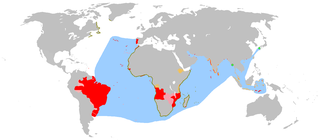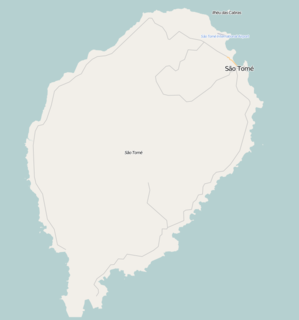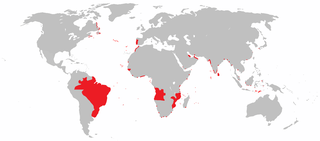
The Carnation Revolution, also known as the 25th of April, was initially a 25 April 1974 military coup in Lisbon which overthrew the authoritarian Estado Novo regime. The revolution began as a coup organised by the Armed Forces Movement, composed of military officers who opposed the regime, but it was soon coupled with an unanticipated, popular civil resistance campaign. The revolution led to the fall of the Estado Novo, the end of 48 years of authoritarian rule in Portugal, and Portugal's withdrawal from its African colonies.
Portuguese creoles are creole languages which have Portuguese as their substantial lexifier. The most widely-spoken creole influenced by Portuguese is the Cape Verdean Creole.

Portuguese is spoken in a number of African countries and is the official language in six African states: Angola, Mozambique, Guinea-Bissau, Cape Verde, São Tomé and Príncipe and Equatorial Guinea. There are Portuguese-speaking communities in most countries of Southern Africa, a mixture of Portuguese settlers and Angolans and Mozambicans who left their countries during the civil wars. A rough estimate has it that there are about 14 million people who use Portuguese as their sole mother tongue across Africa, but depending on the criteria applied, the number might be considerably higher, since many Africans speak Portuguese as a second language, in countries like Angola and Mozambique, where Portuguese is an official language, but also in countries like South Africa and Senegal, thanks to migrants coming from Portuguese speaking countries. Some statistics claim that there are over 30 million Portuguese speakers in the continent. Like French and English, Portuguese has become a post-colonial language in Africa and one of the working languages of the African Union (AU) and the Southern African Development Community (SADC). Portuguese co-exists in Guinea-Bissau, Cape Verde, and São Tomé and Principe with Portuguese-based creoles, and in Angola, Mozambique, and Guinea-Bissau with autochthonous African languages.

The Portuguese-speaking African countries, also known as Lusophone Africa, consist of six African countries in which the Portuguese language is an official language: Angola, Cape Verde, Guinea-Bissau, Mozambique, São Tomé and Príncipe and, since 2011, Equatorial Guinea. The six countries are former colonies of the Portuguese Empire. From 1778 until independence, Equatorial Guinea was also a colony of the Spanish Empire. In 1992, the five Lusophone African countries formed an interstate organisation called PALOP, a colloquial acronym that translates to African Countries of Portuguese Official Language. The PALOP countries have signed official agreements with Portugal, the European Union and the United Nations, and they work together to promote the development of culture and education and the preservation of the Portuguese language. Together with Portugal and Brazil in 1996, the Portuguese-speaking African countries established the Community of Portuguese Language Countries, which East Timor later joined in 2002 and Equatorial Guinea in 2014.

Centro Nacional de Artesanato e Design is a museum in the city of Mindelo on the island of São Vicente in Cape Verde. It situated at the north end of Praça Nova in the city centre of Mindelo. It exhibits works of popular culture, design and crafts.
Universidade Lusófona de Humanidades e Tecnologias is the largest Portuguese private university, and the main institution of Grupo Lusófona, which administers other universities and colleges in Portugal, Brazil, Cape Verde, Angola, Guinea-Bissau and Mozambique. Indeed, promotion of Lusophony is seen as a major objective of the institution; students from former Portuguese African colonies pay substantially reduced fees.
Raúl Pires Ferreira Chaves was a Portuguese civil engineer and inventor. A graduate of the Instituto Superior Técnico of Lisbon, he lived and primarily worked in Portugal, Portuguese Cape Verde and Portuguese Guinea.
Jorge Ferreira Chaves was a Portuguese architect.

Cape Verde was a colony of the Portuguese Empire from the initial settlement of the Cape Verde Islands in 1462 until the independence of Cape Verde in 1975.

Portuguese colonial architecture refers to the various styles of architecture that the Portuguese built across the Portuguese Empire. Portuguese colonial Architecture can be found in the plethora of former colonies throughout South America, North Africa, Sub-Saharan Africa, India, Oceania, and East Asia. Many former colonies, especially Brazil, Macau, and India, promote their Portuguese colonial architecture as major tourist attractions.
The following is a timeline of the history of the city of Maputo, Mozambique.
The following is a timeline of the history of the city of Luanda, Angola.

The Centre for Lusophone and European Literatures and Cultures of the Faculty of Letters, University of Lisbon (CLEPUL) is a research unit of the University of Lisbon based on the Faculty of Letters of the University of Lisbon. CLEPUL was founded by Jacinto do Prado Coelho after the Carnation Revolution, at the time with the designation of Centre for Portuguese Literatures of the Universities of Lisbon. Its main purpose is the promotion and research on literatures and cultures of the Lusophone countries.

The Presidential Palace of São Tomé e Príncipe is the official residence of the President of the Republic of Sao Tome and Principe and located in the capital, São Tomé. The structure was built in the mid-19th century as an administrative center for the governor of the colony, renovated in 1954, and became the residence of the president of the country at the time of independence of São Tomé e Príncipe in 1975.
The following is a timeline of the history of the city of Bissau, Guinea-Bissau.
The following is a timeline of the history of the city of Benguela, Angola.

Patrice Lumumba Preparatory School is a lyceum located in the southwestern part of the city centre of São Tomé, São Tomé and Príncipe. It is the oldest secondary school in the country, established in 1952. It currently has about 3,000 students.
The following is a timeline of the capital city of São Tomé as well as Água Grande District in the island of São Tomé. São Tomé and Príncipe.













